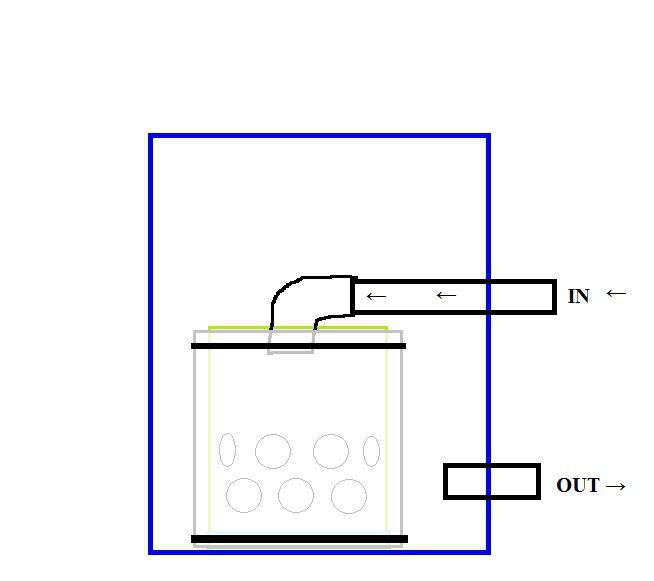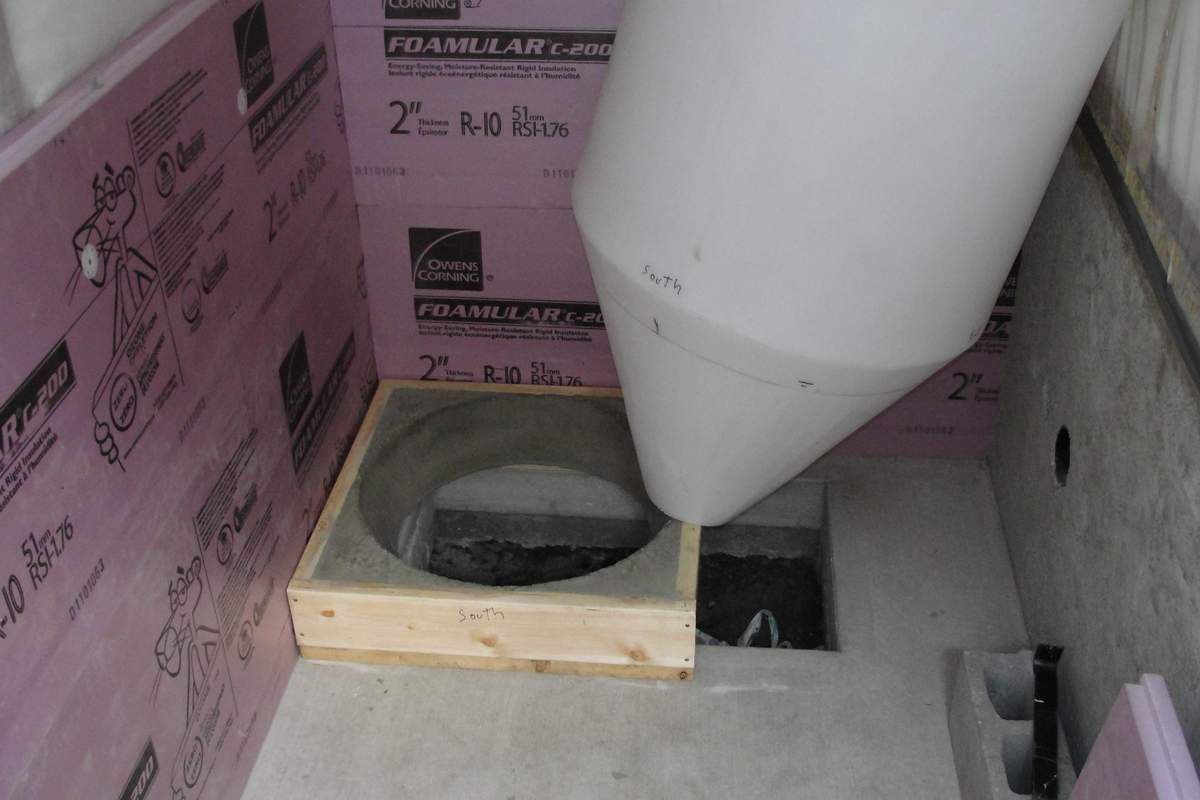Without really even consciously thinking about it I've made a series of improvements to my pond's filter system this spring that I should have done long ago.
The first improvement is in my last filter tank where I have a homemade clarifying filter that removes fine particles from the water before going back to the pond. It consisted of a bucket converted into a sort of canister wrapped in quilt batting.
The canister sits inside a barrel with a gravity fed inlet pipe running inside and the water filters through the canister that is wrapped in quilt batting and the filtered water is pumped out back to the waterfall and back into the pond.
It sort of looks like this.

The basic design works well, but the problem was the quilt batting filter material. Although it worked very well for filtering the water the quilt batting itself was not very durable. It tended to stretch and thin over time and would start to fall apart after repeated washing's, so after years of putting up with that I finally purchased some new material (Aero-Flo) material. This material is much stronger and does not stretch and was designed to be washable. It works much better. Here is a picture of what it actually looks like in the tank. One in the water and one ready to go in when the other one needs washing. The concrete block you see is just there to just help hold the canister in place so the slip fit intake pipes don't come apart.

The next improvement I already mentioned in a another thread was sort of actually started last year when I purchased some floating media to turn my biological tank from a static media bio-filter into a "moving bed" bio-filter. It also has been working well and because the moving bed media is self cleaning it means less maintenance, and by all accounts is a much more efficient biological filtering system then static submerged media.

The final improvement is one that I kick myself the most for not doing long ago.
It has to do with the bucket you see on the bottom right and the tiny little lever you see in this next picture. The little lever I'm talking about is on the left side of that wooden table with the red arrow pointing to it.

The white tank is my cone shaped settling tank. The bottom of that settling tank is below the ground level and looked like this before being installed and plumbed in.

The idea of this tank is that solids from the pond gravity flow into this tank and settle and concentrate at the narrow bottom of the tank. After enough waste accumulate you open a valve and allow the concentrated waste solids at the bottom of the tank to drain out. I had previously rigged some drain line to come up back up and out of the hole so that the waste water could drain into a bucket at floor level, but the valve was still located down in the hole near the bottom of the tank, which meant that to access it to open and close the valve you had to lay on the ground and reach down into the hole in the floor. Something that was not really very comfortable to do.
Long story short, I finally installed a gate valve and hooked up an extension rod to it so the gate valve could easily be opened and shut simple by pulling on the little lever on top of the table, while standing erect like a human.
Wow! What a difference. Before I use to put off draining the waste from that tank because of the contortions involved in lying down and reaching down in that hole. Now, every time I go in there I get an urge to pull that lever and flush out what little wastes may have accumulated.
Here's what it looks like down in the hole. You can see the red handled PVC valve I use to have to reach in and turn before, but just leave open now because the gate valve works as the main shut off valve. You can see the extension rod, attached to the top of the gate valve with black tape and zip ties, extending up and to the top right of the picture.

Anyway, a few little improvements have made my pond maintenance a lot easier, even enjoyable.
The first improvement is in my last filter tank where I have a homemade clarifying filter that removes fine particles from the water before going back to the pond. It consisted of a bucket converted into a sort of canister wrapped in quilt batting.
The canister sits inside a barrel with a gravity fed inlet pipe running inside and the water filters through the canister that is wrapped in quilt batting and the filtered water is pumped out back to the waterfall and back into the pond.
It sort of looks like this.

The basic design works well, but the problem was the quilt batting filter material. Although it worked very well for filtering the water the quilt batting itself was not very durable. It tended to stretch and thin over time and would start to fall apart after repeated washing's, so after years of putting up with that I finally purchased some new material (Aero-Flo) material. This material is much stronger and does not stretch and was designed to be washable. It works much better. Here is a picture of what it actually looks like in the tank. One in the water and one ready to go in when the other one needs washing. The concrete block you see is just there to just help hold the canister in place so the slip fit intake pipes don't come apart.

The next improvement I already mentioned in a another thread was sort of actually started last year when I purchased some floating media to turn my biological tank from a static media bio-filter into a "moving bed" bio-filter. It also has been working well and because the moving bed media is self cleaning it means less maintenance, and by all accounts is a much more efficient biological filtering system then static submerged media.

The final improvement is one that I kick myself the most for not doing long ago.
It has to do with the bucket you see on the bottom right and the tiny little lever you see in this next picture. The little lever I'm talking about is on the left side of that wooden table with the red arrow pointing to it.

The white tank is my cone shaped settling tank. The bottom of that settling tank is below the ground level and looked like this before being installed and plumbed in.

The idea of this tank is that solids from the pond gravity flow into this tank and settle and concentrate at the narrow bottom of the tank. After enough waste accumulate you open a valve and allow the concentrated waste solids at the bottom of the tank to drain out. I had previously rigged some drain line to come up back up and out of the hole so that the waste water could drain into a bucket at floor level, but the valve was still located down in the hole near the bottom of the tank, which meant that to access it to open and close the valve you had to lay on the ground and reach down into the hole in the floor. Something that was not really very comfortable to do.
Long story short, I finally installed a gate valve and hooked up an extension rod to it so the gate valve could easily be opened and shut simple by pulling on the little lever on top of the table, while standing erect like a human.
Wow! What a difference. Before I use to put off draining the waste from that tank because of the contortions involved in lying down and reaching down in that hole. Now, every time I go in there I get an urge to pull that lever and flush out what little wastes may have accumulated.

Here's what it looks like down in the hole. You can see the red handled PVC valve I use to have to reach in and turn before, but just leave open now because the gate valve works as the main shut off valve. You can see the extension rod, attached to the top of the gate valve with black tape and zip ties, extending up and to the top right of the picture.

Anyway, a few little improvements have made my pond maintenance a lot easier, even enjoyable.
Last edited:

